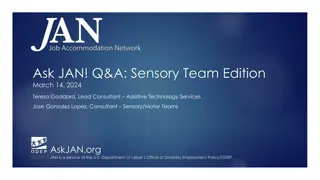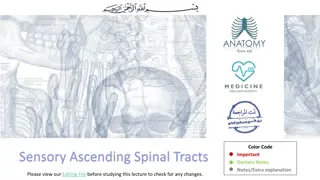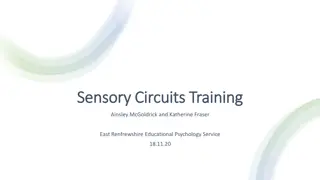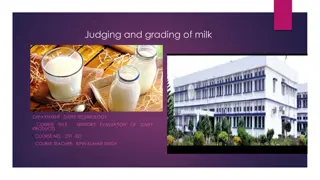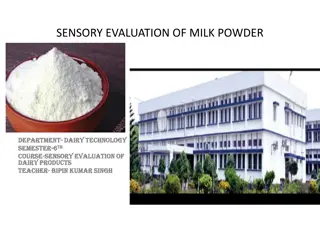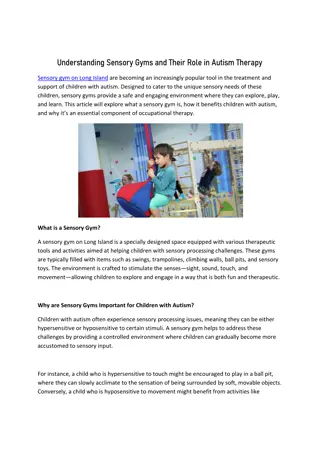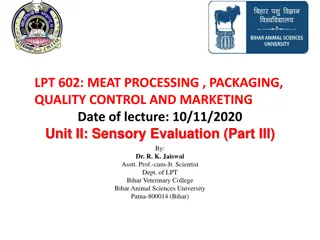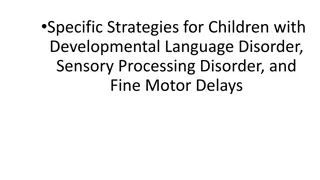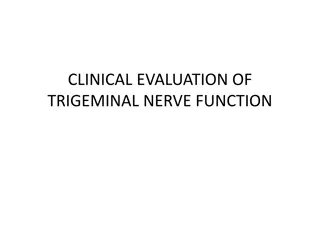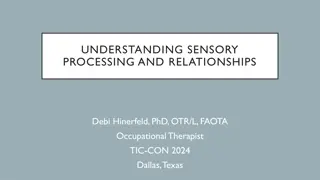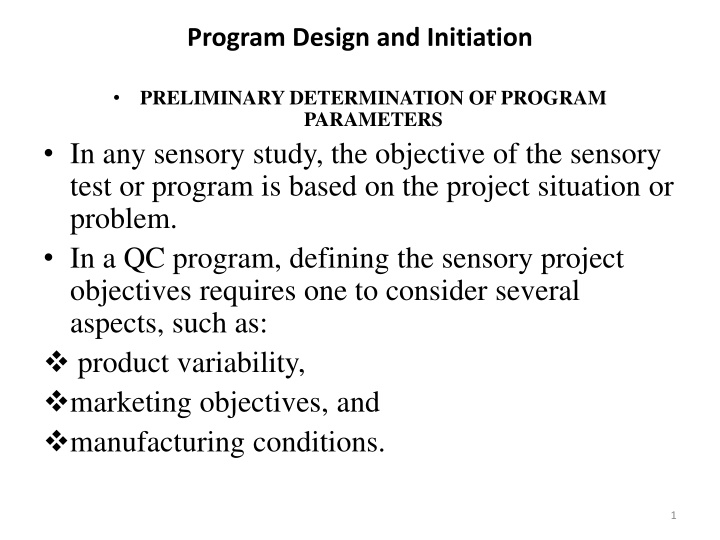
Sensory Program Design Considerations and Initiatives
In a Quality Control (QC) sensory program, determining program parameters is crucial for success. Factors such as product variability, marketing objectives, and manufacturing conditions must be considered. Companies must monitor sensory properties to understand consumer responses accurately. Critical decisions include product consistency across markets and identifying products for inclusion in the program. These considerations shape the efficiency and effectiveness of a QC sensory program.
Download Presentation

Please find below an Image/Link to download the presentation.
The content on the website is provided AS IS for your information and personal use only. It may not be sold, licensed, or shared on other websites without obtaining consent from the author. If you encounter any issues during the download, it is possible that the publisher has removed the file from their server.
You are allowed to download the files provided on this website for personal or commercial use, subject to the condition that they are used lawfully. All files are the property of their respective owners.
The content on the website is provided AS IS for your information and personal use only. It may not be sold, licensed, or shared on other websites without obtaining consent from the author.
E N D
Presentation Transcript
Program Design and Initiation PRELIMINARY DETERMINATION OF PROGRAM PARAMETERS In any sensory study, the objective of the sensory test or program is based on the project situation or problem. In a QC program, defining the sensory project objectives requires one to consider several aspects, such as: product variability, marketing objectives, and manufacturing conditions. 1
These considerations have an impact on important decisions of the QC/sensory program, such as: selecting the product category, points within the process at which to evaluate, the plants to be included, the key sensory attributes to be evaluated, the product sampling, and the test method to be used. 2
Companies cannot hope to understand consumer acceptance, consumer complaints, or shifts in "market share, without monitoring the product's sensory properties that drive these consumer responses. The key sensory test objective of a QC/sensory program is to: develop an efficient way to understand the key attributes that affect consumer liking or acceptance, to assess which raw materials and processing variables affect the final sensory properties, and to develop the most efficient and timely system to measure and control these sensory attributes that are so important to consumer acceptance. 3
One critical marketing decision that must be made within the company when establishing a QC/sensory program is whether the selected product is expected to be consistent across the geographic area in which it is marketed. This may be a regional, national, multinational, or global product. A key question to be determined by marketing and upper management is whether the product is expected to be the same, in terms of sensory properties, in all markets or different ones, depending on the market. Until this critical decision about deliberate consistency or variability of product by location is made, no QC/sensory program can be implemented to measure and control variability. 4
Identification of Products to be Included in the Program Companies that produce a variety of products need to decide which products in which product categories are to be included in a QC/sensory program and in which order each product is to be introduced into the system. Within a company's general QC program, all products are tested for one or more physical or chemical properties, as a test of product consistency. 5
Similarly, any QC/sensory program should encompass and evaluate every product. In the initial design of a QC/sensory program, it may be desirable to include all products, but it may also be impractical because of the requirements in terms of time, money, and personnel to do all products simultaneously. 6
Therefore, one or a few products need to be selected as the "first" or "test case" in the program. This product selection requires careful consideration of several criteria, by which to determine the best choice for the start of the program. Some criteria to be considered are market position, critical problems, production variability, and multiple plants. 7
Market Position The products that yield the largest profits for a company are those usually included first in the system. Position in the market place implies high consumer acceptance of the product's sensory attributes and requires assessment and control of these products and their sensory attributes. 8
Critical Problems A sensory defect in a product that is considered unacceptable by management or the product's consumers (such as the presence of an off-flavor or off-color and its persistence across several production days) is the most important reason for including a product in a QC/sensory program. This decision is especially critical, if the problem has already begun to affect consumer acceptance, demonstrated by consumer complaints, loss in shares, or poor performance in consumer tests. 9
The negative consequences of shipping product with a sensory problem to loyal consumers, because of an inability to detect and control such problems, strongly justifies measuring and controlling that product's sensory attributes. Sensory measurement may be the only way to determine a product's critical problems, as well as the level of variability in production. 10
Production Variability Consumers want products not only high in quality and low in defects, but also with a consistent quality. Therefore, products with large production variability should be considered as candidates for the QC/sensory program because of the potential negative impact on consumer acceptance. A program, which can measure and control production variability, should include those products with large production variability. With many products, instrumental methods may not be able to measure or track product variability. 11
Multiple Plants Although a lesser consideration, companies with more than one production facility may choose to include a product that has met one or more of the above criteria and is produced at more than one plant. This permits study of quality and consistency across plants. 12
Points of Evaluation Within the Process Early in the program, a decision must be made concerning which stages of the process require evaluation of samples. Finished products are of primary interest in a QC/sensory program, since these are the products that the consumer sees and, thus, accepts or rejects. However, earlier in the process, both ingredients and in-process materials can be evaluated as part of a total QC/sensory program. 13
Raw Ingredients/Materials Once an inferior or defective raw material enters a process, the defect may be magnified several times, as the defect is incorporated into and thus becomes detectable in the finished product. One very deliberate and effective way to control the quality of a product is to control the quality of the materials used in producing that product. Therefore, evaluating and controlling the incoming raw materials' sensory properties offer a significant opportunity to monitor and eliminate variation early in the process, thus saving time, money, and product. 14
When possible, every effort should be made to develop a QC/sensory effort to evaluate all or most raw ingredients by 1) setting ingredient sensory specifications, 2) conducting regular evaluations upon receipt at the plant, and 3) making decisions as to the disposition or blending of inferior raw ingredients. Selecting the raw ingredients to be monitored is determined by the finished products to be controlled and by the critical sensory attributes of those finished products known to impact on consumer acceptance. 15
It is possible to incorporate the assessment of many raw ingredients into a program, since the analysis of raw ingredients generally consists of the evaluation of only one or two attributes as opposed to five to ten attributes, in most finished products. One raw ingredient may be incorporated into several finished products. Therefore, the control of only a few raw ingredients may influence the control of several finished products. In contrast, selecting in-process materials and finished products for a QC/sensory program is more complex. 16
Understanding the relationship between raw ingredient sensory attributes and the sensory properties of the resulting finished products allows for the eventual shift from the more complex multi- attribute evaluation of several finished products to the simpler, more efficient evaluation of a few key attributes of a few key raw ingredients. This system insures a quality product through early control, rather than through large scale disposition or rework of finished product. 17
In Process For some processes, there are critical points at which sensory tests can be done to measure and control the introduction of sensory attributes into the product. Just as analytical chemical and physical tests are conducted at stages throughout a process, QC/sensory monitoring is recommended at critical stages in production, where interim product quality reflects the quality of finished product. When a batched lot of one phase of a product, such as a dough premix for a cookie or a fragrance blend with carrier for a household product, are introduced into the process, this in-process phase or batch can be tested for key sensory attributes. Often, the reaction of raw materials to partial processing reveals characteristics that are not desirable in the finished product. As with raw materials, if defective or variable in-process products can be identified and held before final processing, conversion, or inclusion with other in-process materials, the result is the saving of time, production costs, and product. 18
Finished Product Since almost all consumer products are purchased for their sensory properties, as well as other performance characteristics, it behooves managements of consumer products companies to monitor the sensory properties of their products before they are shipped to the marketplace. In spite of an effort to control the sensory quality of a product by monitoring and controlling raw materials, it is, at least initially, necessary to evaluate the sensory characteristics of finished product. The interaction of raw materials and/or the effects of processing on the already cleared raw materials requires monitoring. 19
The appearance, fragrance, or flavor and texture properties can be monitored for some time period, to learn the variability per se and its relationship to any variability in the raw materials. Once management and the QC/sensory team understand how raw materials affect finished product, it is possible to reduce the frequency of evaluation of the finished product. Quality control of consumer products often includes the instrumental analysis of chemical and/or physical properties at different processing stages, but often does not include monitoring appearance, aroma, flavor, or texture of these same products. In many cases, quality control sensory measurements early in the process can also reduce the need for frequent sampling of finished product. This is especially true when the effects of early detection of problems have been related to problems in the finished product. 20
Sensory Attributes Evaluated in a Product Two major factors determine which sensory attributes are to be evaluated in a product: attributes with variability and attributes that drive consumer acceptance. These criteria are relevant to those attributes that define raw materials, in-process product, or finished product. Only the sensory attributes of finished product can be directly evaluated by consumers. However, the effects of variation in the sensory properties of raw materials and in-process product can be related to the sensory attributes found in finished product. 21
Attributes with Variability Product variability is a major reason for a product to be included in a QC/sensory program. The product variability in sensory terms is measured as variability in sensory attributes. Generally, sensory attribute variability can result from the presence of an "off-note" in a product, or from the variation in intensity or strength of sensory attributes that are normally found in the product. An off-note is a sensory attribute (plastic flavor, bitter taste, gritty texture, a color) that is not present in the product under the best or optimum conditions. The particular attribute is considered "atypical" of the product profile and may be the reason for a rash of consumer complaints. 22
The shift in level or intensity of the characteristics typical of the product is a potential source of product variability. Although a product may possess the proper set of attributes, one or more may be shifted out of the normal intensity range (too sweet, not crisp enough, too dark, not shiny enough). In these cases, any one attribute may be too high or low, or more than one attribute may be outside what is typical for regular production or a designated control. Therefore, the attributes to be included are those that vary outside the normal range for the typical product and those that are "off-notes" or not normal for the product. 23
Attributes that Drive Consumer Acceptance One of the most surprising aspects of measuring both sensory attribute variability and its impact on consumer acceptance or liking is that the size of the variability in an attribute is not necessarily related to the size of its effect on consumer responses. When consumers see a wide range of color intensity in cookies or potato chips in one package, they may respond negatively only to the extremes, and may rate a very wide range of color as highly acceptable. Consumers may also find a wide range of fragrance levels acceptable in personal products. Conversely, however, a low-level indication of staleness or rancidity in the cookies or potato chips may yield dramatic loss of consumer acceptance. 24
The criteria for including sensory attributes into the QC/sensory program are 1) those that induce negative reactions in consumers and loss of consumer acceptance and 2) those that management feels are too broad a range to represent a clear concept of the product. Chapters 3 to 6 cover the different methods that can be used in a QC/sensory program and include a discussion of attribute selection for a variety of consumer products, as well as the criteria used in attribute selection. 25
Sampling During the phase of identification of the parameters to be included in the QC/sensory program, it is necessary to determine the amount of sampling that will have to be done to understand the variability across products, attributes, and plants. Preliminary information may be available that indicates certain plants vary more than others because of the processing equipment or ingredient sources. Certain key attributes may be a problem only on certain shifts or specific times of a start-up on a production line. 26
Early assessment of the scope and frequency of product variability provides a clue to the possible sampling schedule needed during the preliminary implementation phase. It is from careful evaluation of possible sources of variability that an effective sampling plan can be developed, to cover variability across plants, products, and attributes. Several references can be used to present technical approaches for determining the best sampling plans for a wide variety of product variability interactions. 27
IDENTIFYING RESOURCES After the characteristics of the QC/sensory program are determined, the next step, before the design and implementation phase, is assessing all possible resources that are available to support the program. The areas to be studied include: the methodology, the personnel, the physical facilities, management support, and the availability of outside resources. 28
Methodology Recommended Methods Within sensory evaluation, there are several sensory methods to meet project objectives in basic research, product development and improvement, product maintenance, and marketing/marketing research. Given the nature of manufacturing and quality control requirements, the sensory evaluation methods that are best suited to meet those QC needs are those that measure variability. These methods include those that utilize ratings and those that assess overall conformance to a product concept. 29
Rating Methods Methods that involve ratings of 1) attribute intensities, 2) quality, or 3) difference afford the sensory analyst the capability of determining a degree of variability from some target control or specification limit. The three methods prescribed in Chapters 3, 4, and 6 fall into this category. Each is described below with general application, advantages, and disadvantages. 30
The Comprehensive Descriptive Method This method involves the rating of intensity of individual key attributes, for which specifications are set. This method identifies the samples that are out of spec and to what degree for each attribute. Application: For a company's major flagship brand, this method careful assesses product variability, in terms of both key attributes and the direction they may vary. Such in-depth information provides direction in making changes in ingredients or process to increase greater product conformance. 31
Advantages:This method provides the most detailed information about "what" is varying in a product, the size of that variability, and the direction (too high or too low), relative to the product specifications. This method most closely resembles the evaluation of other physical or chemical characteristics that are integral parts of a broad scope QC program. Disadvantages: This approach is costly and time consuming, mainly for two reasons: the sensory tests required (e.g., descriptive and consumer research tests) and the time and resources needed to establish and maintain the program (e.g., extensive training samples and references needed). 32
The Degree of Difference/Difference from Control Method. This method involves rating each sample in terms of the size of the difference from a designated control. A cut off point is designated to assess which products or ingredients are too different from the control to be within specification limits. Application:When product or ingredient variability follows a single continuum, from the control to less desirable or "off' production samples, this method provides a simple, one-step, method for assessing out of spec samples. 33
Advantages: This method requires few resources and little time to implement. Only one set of training references is needed, to establish a range of products from the control (not different to those very different from the control). Panelists need to learn to use only one continuum by which to judge sample conformance. Disadvantages:A difference from control rating only defines the size of the difference from the target control but fails to provide information on the reasons for the difference. To establish the cutoff for "too different," some consumer research is required. 34
The Quality Rating Method This method involves rating each sample and/or some set of key attributes for quality. A specification is established for each attribute scale, to determine proper disposition of the tested sample or product. Application: In industries or corporations where quality of a product or ingredient is commonly understood, developing quality criteria overall and for specific attributes can be done quite easily and can be used effectively. Advantages: A quality rating program has broad history and understanding in consumer products, especially among food commodities. Therefore, the data are easily understood and interpreted by management 35
Disadvantages:In cases where the notion of "quality" of a product is subject to individual personal preferences, the vagaries of shifting product concept, or the competitive set, quality ratings are not recommended. The shifting criteria create an inconsistent rating system. In addition, the training can be very complex, if common quality criteria are developed and used. 36
Nominal Methods Methods that allow trained panelists to decide if a given sample is within or outside of a product concept are also applicable in a QC/sensory program. In a QC application, the concept represents the range of attribute intensities considered "acceptable" or "in- spec. The "in/out" method requires the initial careful definition of the characteristics of "in" or "acceptable" product. 37
The subjects involved in product evaluation are shown several examples of the sample, a product, or raw ingredient, some that are within the product limits or acceptable concept ("in") and some that are outside the product limits or concept ("out"). During subsequent testing, these trained panelists are expected to determine if the test products or raw materials fall in or out of the designated "acceptable" product concept. 38
Application: The choice of the "in/out" method is appropriate for those situations in which 1) a simple yes/no answer provides sufficient information for QC/sensory, 2) the capacity to identify and/or retain reference samples is limited, or 3) the resources to train and maintain one of the more complex rating methods are unavailable. Advantages: The simplicity of having only one criterion, one evaluation, and one simple result is a significant advantage of the "in/out" method. Training panelists is relatively easy, and QC management knows immediately which samples to ship. 39
Disadvantages:Conversely, the simplicity reduces the amount of specific information about the reasons for a sample's "out" designation. Decisions on disposition require some further assessment of how "out" the sample is. Only then can efforts be made to correct the ingredient or process conditions that contributed to the product's "out" rating. A major disadvantage is that the decision process, normally left to QC, is part of the "in/out" method. Rather than providing evaluations and ratings that are used to decide on the acceptance or rejection of the product, judges using the "in/out" method decide directly yes/no or accept/reject, as part of the judgments. 40
Methods to Avoid Some tests, such as most Overall Difference tests, are not effective for QC sensory work. Triangle, Duo-Trio, A/NOT A, and Simple Difference tests are very sensitive to fairly small differences. Therefore, by yielding only "different" or "not different" answers, they tend to lead to rejection of a large proportion of regular production through the assessment of only statistically significant differences. The amount of difference is often the key question in a QC environment, and difference testing alone will not determine the size of the difference. Affective responses, including preference and acceptance, are not appropriate for routine production evaluation. 41
The determination of the preferences or liking of a small group of plant personnel does not represent the population that routinely uses the product. However, it should be noted that some affective acceptance tests using a large consumer base from the population of users should be utilized in every QC program. The acceptance information, used in conjunction with other sensory tests at the early stages of a QC program, help determine how variation in certain attributes drive the acceptance of a product. This affective information is used to set the sensory specifications. 42
Personnel The success of a QC/sensory program relies heavily on two categories of personnel: the sensory professional(s), who are responsible for program design and execution, and the sensory panelists, who are responsible for the routine evaluation of products and/or raw materials. Sensory Staff Designing, administering, and implementing the QC/sensory program require the expertise of different sensory professionals, depending on the size and scope of the program. The personnel requirements for a given program might include: a sensory coordinator, a sensory professional at each plant, and one or more sensory technicians working with the plant sensory professional and R&D sensory coordinator. 43
The R&D sensory coordinator may be a member of the current QC staff who shows some interest in the sensory activity. In such a case, sensory training regarding methodology, panelist management and training, and test controls is critical. More often, the sensory coordinator comes from R&D and is given the responsibility for the QC/sensory program across several plants. This individual may have the sensory qualifications, but requires some grounding in plant and QC practices and in product ingredients and processing. In most companies, the R&D sensory coordinator has a reporting relationship to both the R&D sensory manager and the QA/QC team or director. 44
The R&D sensory coordinator has the following responsibilities: Oversee the initial design of the QC/sensory program, by working with QC upper management. Define the scope of the program in terms of the products, attributes, processing steps, and sampling schedule to be included in the testing. Assess the companies current potential resources in terms of methodology, personnel, facilities, management commitment, and support functions. Design and develop the sensory program in conjunction with the quality control department, in terms of selecting and implementing the approach and preliminary stages of the QC/sensory evaluation program. 45
Interview, select, and train plant sensory professionals, as each plant is brought into the system. Set criteria for screening and selecting panelists at each plant. Develop and conduct a training program to be implemented at each plant on the start-up of each plant program. Oversee the initiation of the established program after training. Be a resource consultant to all plant sensory analysts. 46
Coordinate the QC/sensory program across all plants in terms of panelists performance, data handling, and reporting. In addition, oversee dissemination of the QC/sensory program results to QC and the other functions within the company. The plant sensory analyst has the following responsibilities: Assist the R&D sensory coordinator in implementing the preliminary stages of the QC/sensory program. Screen, select, and assist in training subjects as plant panelists to evaluate samples according to the designated program methodology. Manage samples, references, and controls (for product and raw materials) in terms of pickup, logging, and storage, in accordance with the program's prescribed sampling plans. 47
Supervise the preparation and presentation of the samples for each evaluation session, using strict test protocols to minimize bias due to poor product handling. Coordinate panelists and the schedule of evaluation sessions. This includes working with panel supervisors to assure full and timely attendance. Maintain the technical skills and motivation of panelists. Manage the maintenance of the sensory facility and supplies. Manage sessions, to insure compliance to the test evaluation protocols for each panelist. 48
Collect and compile data for each sample and report. Maintain interaction with R&D coordinator for technical issues and growth of the program. One or more QC/sensory technicians may be required to assist the R&D sensory coordinator and each plant sensory analyst in the following responsibilities: Implement the routine sample handling. Conduct the routine sensory tests. Contact and schedule panelists and tests. Enter or record data from each test. 49
Panelists As with any QC measurement, the "instrument" is a critical consideration. In sensory evaluation, the panelists are the measurement tool. Issues to consider when selecting, training, and maintaining panelists are as follows. Selection Panelists may be recruited from within the plant or R&D site where evaluations are to take place or from the neighboring community. Plant employee panelists may include line workers (when union and personnel limitations have been considered) or office staff, if use of line workers is limited or untenable. 50

